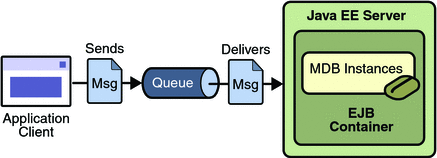simplemessage Example Application Overview
The simplemessage application has the following components:
SimpleMessageClient: An application client that sends several messages to a queue
SimpleMessageEJB: A message-driven bean that asynchronously receives and processes the messages that are sent to the queue
Figure 23-1 illustrates the structure of this application. The application client sends messages to the queue, which was created administratively using the Admin Console. The JMS provider (in this case, the Application Server) delivers the messages to the instances of the message-driven bean, which then processes the messages.
Figure 23-1 The simplemessage Application

The source code for this application is in the tut-install/javaeetutorial5/examples/ejb/simplemessage/ directory.



